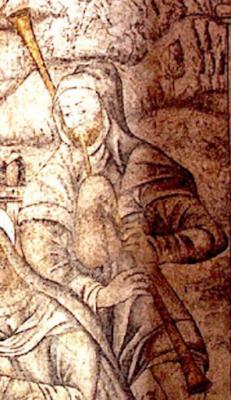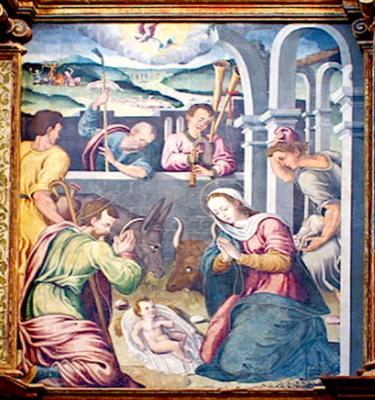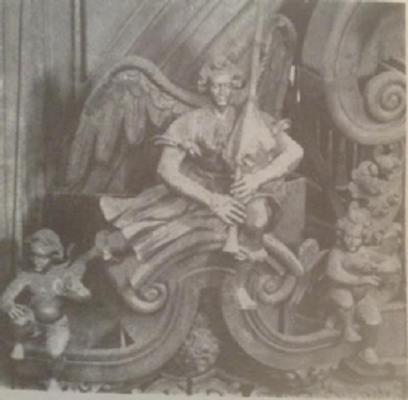The Bagpipe Society
Bagpipes in Colonial Mexico
In this article I put forth observations concerning iconographic and literary sources, and their use as literary symbols.
The bagpipe is not an instrument that forms part of Mexican popular culture and up to the date, there are no works of colonial music that explicitly mention its use, although we start to see more concrete evidence of the use of the bagpipe up until the late 19th century. However, in this article I intend to document its presence in iconography and literature — and possibly its use — during the Viceregal Period of New Spain, from 1521 through 1821.
The first missionaries that arrived in Mexico brought many European musical instruments with them. It is well documented by Friar Motolínea that the first European music school in the American continent was founded by Fr. Pieter van der Moere in Texcoco, Mexico in 1530. The natives were taught how to play and make their own instruments (Weckmann, 1994).
The earliest known mention of the bagpipe in Mexico dates to 1555 in Fray Alonso de Molina’s Nahuatl-Spanish dictionary Aquí comienza un vocabulario en la lengua castellana y mexicana under euauilacapitztli. (Molina, Aquí comienza un vocabulario en la lengua castellana y mexicana, 1555). The term is derived from euatl/euauil ‘raw hide’, aca ‘reed, cane’, and pitzli/pitzali flute (Stanford, 1966).
Later, as he expanded his dictionary in 1571, de Molina added the verb euauilcapitzoa ‘to play the bagpipe’. (Molina, Vocabulario en lengua castellana y mexicana, 1571). De Molina prepared this vocabulary and rendered the names of many instruments in Nahuatl in order to familiarize the natives with the new culture, with the goals of evangelization and gaining political leverage.


The first known graphic representation of bagpipes appears in religious iconography and is found within the murals of the church of St. Miguel Arcangel in Ixmiquilpan, Hidalgo, which include a nativity scene featuring a bagpiper. This fresco was painted by the natives as an evangelization exercise and is unique in its inclusion of elements not present in any other murals, such as deities from the pre-Columbian religion. It is probable that the scene is a copy of European iconography from the time due to the unrealistic proportions of the chanter, as is the case with many other imaginary instruments appropriated in Novohispanic iconography (Roubina, XXVI, Nº 26, 2012). Accordingly, this mural cannot be considered as evidence of the use of the bagpipe in New Spain. “The Indians, friars of St. Austin, have been indoctrinated. They celebrate the festivities with the music of organs, flutes, shawms, bagpipes (cornamusa) and other instruments”. (Mendoza…, 1864)

The use of a bagpipe is possibly mentioned in 1609 in a chronicle of the town of Huauhchinango, Puebla, where the chronicler describes how the natives of the region celebrated the festivities playing flutes, shawms, and cornemuses.
This description fits quite well the formation of a Catalunian *Cobla, * where the sac de gemecs was played along with flutes, *gralls *(a Catalunian folk oboe also known as xeremíes or xirímias) and drums, etc. (BALOSSO-BARDIN, 2015). During this time, the Word cornamusa was still a term in use to refer to gaitas. (Orozco, 1611) Another preserved iconographic example is found in the main altarpiece of the church of St. Francis Cuahtinchán, which depicts the adoration of the shepherds. Dating to the sixteenth century, it is one of the oldest Franciscan altarpieces in Mexico. Although it is not known exactly who was the original artist, unlike in the previous mural, all of the possible artists were Spanish missionaries. It is known the paintings were retouched in 1612 by the Mexican artist Juan de Arrué. (Morales, 1968)

Following contemporary trends in Spanish literature, many gaitas gallegas were written and composed in New Spain. Gaitas gallegas were a form of Christmas carol during the Spanish golden age written in broken Galician, primarily by Castilian authors that featured bagpipers as shepherds, representing a form of humble Christianity. This trope was heavily influenced by the migration of Galician and Asturian peasants to Castille to do farming jobs. (Cancioneru de la gaita asturiana vol 1. , 2011) Usually, the authors of these carols could not distinguish the social and cultural differences between Asturians and Galicians, which was not accepted at all by both groups. Accordingly, the authors would write in Galician, confusedly using Asturian words, and attribute Asturian elements to Galicians and vice versa. The carols written in Mexico featured the same problems. (Tomé, 1988) The following is a carol for 4 voices composed by Francisco Casillas called “Toquen as gaitas Toribio e Lorente” ‘play the bagpipes Toribio and Lorente’ (Aurelio Tello, 2018)

| Toquen as gaitas | *Play the bagpipes, * |
| Toribio e Lorente, | Toribio and Lorente |
| Tocai os galegos | The Galicians are playing [the bagpipes] |
| e canten os cregos… | *And the clerics are singing… * |
The following anonymous *gaita gallega * was performed at the Christmas mass of 1748 in the cathedral of Michoacán, Mexico, accompanied by violins, violas, oboes and trumpets. (Plancarte, 1952). In it, the linguistic confusion between Galician and Asturian is more noticeable because of the masculine singular ending in –u, used in Asturian.
Eu, Turibiu, Dumingu, Benitu
Oh fillio de deus! Que lindo chiquitu
Ay qué bien suena deleita y agrada la tonadilla y el son de la gaita Ay qué bien suena y agrada y deleita la tonadilla y la gaita gallega.
Me, Turibiu, Dumingu, Benitu
Oh son of God! What a beautiful infant
*Oh how good it sounds, delights, and pleases, the tune and sound of the bagpipe. *
Oh how good it sounds, pleases, and delights, the tune and the Galician bagpipe
Another lyrical use of the bagpipe, also from Puebla, is found in a fragment of the carol “A la xácara xacarilla” Villancico II de los “Maitines de Natividad” from 1653 (Cathedral of Puebla, México) by the Andalusian composer Juan Gutiérrez de Padilla.
…y la gaita baila Gil, que tocaba Antón Pascual
…and Gil dances to the bagpipe, played by Antón Pascual
Next, we find bagpipes mentioned in Tañe Gil tu tamborino (‘play your tambourine, Gil’) a work from 1610 from the Novohispanic composer Gaspar Fernández (Gaspar Fernández, 1990)
Tañe Gil tu tamborino
Y anden la flauta y sonajas
Hágase la gayta rajas
Y el rabel no pierde el tino
Que el cielo divino a fiestas convida
Por la nueva vida
que a la tierra vino.
Sound your tambourine, Gil
As the flute and the bells ring out
Make the bagpipe pierce the air
*and the rebec will not fall behind; *
So the Holy Heaven to the festivities rejoice
For the new life
*that came down to earth. *
And one of the most important Mexican authors of all time, Sister Juana Inés de la Cruz, mentions the sound of the bagpipe guiding a lost pilgrim in one of her carols (Cruz, 1952):
Íbase para Belén en una noche de invierno un peregrino cantando…
Perdió el camino; y perdido,
sonó de una gaita el eco.
Fuése tras la voz sonora del cabrerizo instrumento.
A pilgrim was singing, off to Bethlehem in a winter night
He lost his way, and while lost,
The echo of a bagpipe sounded
He went after the sonorous voice of the goatish instrument.
All of these examples from literature follow the same style and metrics as the carols in Spain. Even the names of certain characters, such as “Gil”, “Toribio”, and “Antón Pascual” are repeated in other works of Spanish origin.
The premier iconographic example was a sculpture of an angel playing the bagpipe, located in one of the organs of the metropolitan cathedral of Mexico City. The organ and its decoration were made in 1735–36, when a new organ was commissioned from the Aragonese organ builder Joseph Nassarre, who lived in Mexico. (Pepe, 2006). The gilt wooden sculpture was unfortunately lost during a fire inside the cathedral in 1967 and we can now only appreciate it through this photograph. (Moreno, 1957)

However, the existence of this sculpture does not mean that the bagpipe was an instrument used by the minstrels in the cathedral. On the contrary, during the late sixteenth century, the use of all instruments except the organ and voice were banned by the clergy (Weckmann, 1994). After the ban was lifted in the eighteenth century, there are no registries within the archives of the council records of bagpipers playing at the cathedral. (Lucero Enríquez, 2001) There is still work to do before reaching a conclusion. Many paintings of colonial convents were lost due to vandalism and pillaging during the Mexican revolution, so we don´t know if more iconography existed. Today, the search for Novohispanic musicians during the viceregal period is a quite active research field in which many academics are engaged. There are still records to look into from Galician and Asturian migrant associations from the 18th century.
Hopefully, new information might be discovered about a colonial bagpiper who settled in the area or was brought by a patron to play at a romería (processional pilgrimage). Such cases are well documented in the late 19th century. There is also the Franciscan codex and the correspondence between Friar Pieter van der Moere and King Phillip II, which includes detailed lists of instruments allowed to be played in churches during the 16th century.
Even though no definitive evidence has yet emerged concerning specific pipers, the inclusion of terms in dictionaries for indigenous populations would argue for their presence: Unless pipers were present, why would the friars need to provide terms for the instruments and their performance in native languages?
My explorations continue as active research and I hope to bring you more information in the future.
References and Further Reading
https://bit.ly/Chanter122 Mexican Mural https://bit.ly/Chanter123 Mexican Mural
In F. F. Eugenio Otero Vega, *Cancioneru de la gaita asturiana vol 1. *(pp. 30-41). Xixón: Muséu del pueblu d’Asturies. (2011).
Aurelio Tello, N. H. (2018). Colección Sánchez Garza: Estudio documental y catálogo de un acervo musical *novohispano. * Ciudad de México: Instituto Nacional de Bellas Artes.
Balosso-Bardin, C (2015). *The Mallorcan Bagpipes (Xeremies): An anthropological Portrait of an Instrument. *
University of London, School of Oriental and African Studies.
Cruz, J. I. (1952). *Obras completas de Sor Juana Inés de la Cruz 2; villancicos y letras sacras. * Ciudad de México: Fondo de cultura económica.
Gaspar Fernández, A. d. (1990). Tesoro de la Música Polifónica en México IV: Archivo Musical de la Catedral *de Oaxaca. Antología de obras. * Ciudad de México: Conaculta, INBA, Cenidim.
Lucero Enríquez, R. H. (2001, Noviembre). Música y músicos en las actas del cabildo de la Catedral de *México. * Retrieved from Scientific Electronic Libray Online: http://www.scielo.org.mx/scielo.php?script=sci_arttext&pid=S0185-12762001000200008
Mendoza…, J. F. (1864). Colección de documentos inéditos relativos al descubrimiento, conquista y colonización de las posesiones españolas en América y Oceanía. In R. A. Indias, Colección de documentos inéditos relativos al descubrimiento, conquista y colonización de las posesiones españolas *en América y Oceanía, Vol IX. * (p. 126). Madrid: Imprenta de Bernaldo de Quirós.
Molina, A. d. (1555). Aquí comienza un vocabulario en la lengua castellana y mexicana.
Molina, A. d. (1571). Vocabulario en lengua castellana y mexicana. In A. d. Molina.
Morales, E. C. (1968). El retablo de Cuahtinchán, Puebla. Historia Mexicana Vol. 18, No. 2 (Oct.- Dec.), 179-189.
Moreno, S. (1957). *Ángeles músicos en México. * Ciudad de México: Revista Bellas Artes.
Orozco, S. d. (1611). *Tesoro de la lengua castellana o española. * Madrid: Luis Sánchez.
Pepe, E. C. (2006). AN ORGAN BY JORGE DE SESMA FOR MEXICO CITY CATHEDRAL. Revista de Musicología, Vol. 29, No. 1, ACTAS DEL I ENCUENTRO DE JÓVENES MUSICÓLOGOS DE
LA SOCIEDAD ESPAÑOLA DE MUSICOLOGÍA, 127-162.
Perry, R. D. (n.d.).
Plancarte, A. M. (1952). Los villancicos de la Décima Musa. In J. I. Cruz, Obras completas de Sor Juana Inés de la Cruz 2; Villancicos y letras sacras (p. 52). Ciudad de México: Fondo de cultura económica.
Roubina, E. ( XXVI, Nº 26, 2012). “Tomo mi bien de donde quiera que lo encuentre" : el problema de las apropiaciones del arteeuropeo en la iconografía musical novohispana. Revista del *Instituto de Investigación Musicológica “Carlos Vega” *, 343.
Stanford, T. (1966). A Linguistic Analysis of Music and Dance Terms from Three Sixteenth-Century Dictionaries of Mexican Indian Languages. In Anuario, Vol. II (pp. 101-159). University of Texas Press.
Tomé, J. L. (1988). El asturiano en el siglo XVIII. Lletres asturianes: Boletín Oficial de l’Academia de la Llingua Asturiana. N. 30, 173-190.
Weckmann, L. (1994). La herencia medieval de México. In L. Weckmann, La herencia medieval de México (pp. 524-525). Ciudad de México: Fondo de cultura económica.
- Data Processing Notice (GDPR)
@BagpipeSociety on X (formally known as Twitter)
TheBagpipeSociety on Instagram
 BagpipeSociety on Facebook
BagpipeSociety on Facebook
Something wrong or missing from this page? Let us know!
